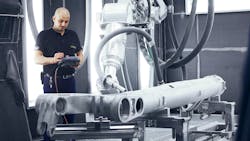Using Automation and Robotics in Maintenance Management
Automation, robotics, and similar digital trends have spread throughout manufacturing for years and remain hot industry trends today. By adopting innovations on the plant floor, manufacturers have improved many aspects of their operations, including line efficiency, product quality, and worker safety, just to name a few.
Just as the production floor has embraced the use of automation and robotics, the maintenance department is beginning to see similar value by putting their own spin on the topics. As experts are predicting more tech in post-pandemic plants, this trend will only grow.
Key drivers for automation and robotics — There are a few factors driving these trends, including automation of repetitive, low-skill tasks. This has been a main driver in production automation, and the same principle applies to maintenance activities. Technicians provide more value when working on complex tasks, such as root cause analysis and correction. Thus, robots can be employed for simple, arduous tasks that don’t require much thought.
This application can be especially true for a preventive maintenance program. Some PM tasks are tedious and time-consuming, and do not lead to insights on the asset.
Another factor driving plant maintenance automation and robotics is worker safety. Many maintenance tasks are inherently dangerous to the technician, and removing this risk provides great value to the worker and the business.
A third cause is standardization. Anyone with some experience in manufacturing knows how much a process can vary from operator to operator. When this variation is removed, significant gains can be recorded.
Robotic inspections — One area where robots have been used for repetitive tasks is in maintenance inspections. These duties are often tedious or difficult to complete, which leads to inconsistent results. Furthermore, the results can vary by inspector leading to non-standard work.
The automobile industry has begun to use robots for inspections. Rolls-Royce is using flexible snake robots to inspect engine lines. They can even make patch repairs while in the engine.
Many other types of robots are being used in automotive industry. For example, Robotic Vision Technologies have developed a robot that can use vision technology with picture capture. The RVT robots can scan an engine and detect a part within 0.1 seconds.
The airline industry is another adopter of robotic inspection. Though airlines may be slow to change their maintenance practices, some operations have adopted robotics-based processes. Lutfhansa Technik is using robots to inspect for cracks on engine components. Previously this involved a messy and tedious, manual process involving dye testing. There is a general recognition that these tasks are performed better by robots. There are other robots used in Lufthansa’s MRO process – component repair, cockpit control testing, and an automated scarfing system called CAIRE.
Automation for maintenance management — A lot of automation in maintenance is the sole result of software support. In an effort to maximize the benefits of industrial maintenance, computerized maintenance management software (CMMS) and other solutions have focused on automating maintenance tasks like PM scheduling, spare-parts inventory forecasts, and various parts of asset management.
Along with sensors this concept can be taken further. When a sensor meets a pre-defined threshold, CMMS solutions with adequate integrations can send out instant alerts and automatically schedule work orders. .
Risk mitigation through robotics —There are numerous other enterprises using robots for inspections, with a goal of removing workers from hazardous environments. The Frauenhofer Institute's Robotics Systems business is one of these, and has developed several robot inspectors. For example, they have robots for sewer system inspections. In this case, the system represents a health hazard for human inspectors, and it cannot be shut down and drained for inspections. So, robots take on the undesirable task of inspecting the sewer line.
There are various other scenarios where robots are performing inspection services. The U.S. Dept. of Energy's Sandia National Labs has partnered with International Climbing Machines and Dophitech to develop a climbing robot that closely inspects wind turbine blades by climbing across the surfaces. There are numerous examples of tank inspection robots. Any facility with hazardous tanks understands the rigmarole and risk of sending people into a tank; A robot inspector is a much better option.
Maintenance assistant — Naturally, all these robots need to be properly maintained themselves. Enter the maintenance robot designed to maintain robots! Secondhands is a robot designed to assist human technicians in the maintenance of other robots.
The concept is that the robot will recognize when the technician needs help – a tool, assistance lifting something heavy, or precision in a technique. This robot will augment the human technician and is designed to make their life easier.
Automation and robotics are proving their worth in maintenance. Technology and cost have come to point where the benefits are clearer than ever before. Whether driven by efficiency, risk reduction, standardization, or a combination of these reasons, robots are guiding maintenance into the future.
Bryan Christiansen is the founder and CEO at Limble CMMS. Limble is a modern, easy to use mobile CMMS software that takes the stress and chaos out of maintenance by helping managers organize, automate, and streamline their maintenance operations.
About the Author
Bryan Christiansen
CEO
Bryan Christiansen is the founder and CEO at Limble CMMS, a mobile CMMS software for organizing, automating, and streamlining maintenance operations.
